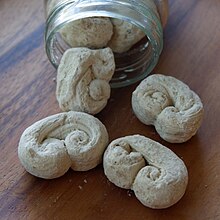 | |
| Alternative names | Balicucha, Balikutsa |
|---|---|
| Type | Sweets |
| Place of origin | Philippines |
| Region or state | Ilocos |
| Main ingredients | Sugar |

Balikucha, also spelled balicucha or balikutsa, is a type of traditional pulled sugar candy from the Philippines. It is made by boiling pure sugarcane juice or crystalline sugar (usually muscovado or palm sugar) until it caramelizes and becomes a syrup. It is then pulled and folded repeatedly against a nail until it turns a creamy white color. The resulting ropes of candy are then cut into sections and curled at the ends, resulting in a distinctive shape similar to palmier pastries. They are allowed to dry under the sun before being sold.
They can be eaten as is and are popular candies for children. They have a hard porous texture that melts in the mouth. They are also commonly used to sweeten hot drinks like coffee, tsokolate, and tea, as they melt quickly. They can also be melted again into a syrup used to sweeten desserts like cariocas (fried glutinous rice balls).
Balikucha is similar to the tira-tira candy of the Tagalog regions (which are also sometimes called balikucha) and butong-butong of the Western Visayas, except that tira-tira are shaped into small sticks and butong-butong is shaped into a coil. Balikutsa is also the name for coconut toffee, a traditional chewy candy from the Visayas and Mindanao islands made from hardened coconut milk and sugar syrup.
Balikucha is celebrated in the annual Balicucha Festival of the town of Santa Maria, Ilocos Sur during the months of March and April.
See also
References
- ^ Cruz, Jashley Ann (19 May 2022). "iJuander: What is Balicucha?". GMA GTV. Retrieved 18 January 2024.
- Medenilla, Vina (16 July 2022). "Going beyond refined sugar: Traditional sweeteners in the Philippines". Manila Bulletin. Retrieved 18 January 2024.
- Miniano, Marcy (17 August 2021). "18 Locally Grown Ingredients From the Philippines That You Need to Try". TripZilla. Retrieved 18 January 2024.
- Polistico, Edgie (2017). Philippine Food, Cooking, & Dining Dictionary. Anvil Publishing, Incorporated. ISBN 9786214200870.
- "The Peculiar Life of a Buri Palm and an illustrated Philippines sugar map". Meryenda. 10 October 2022. Retrieved 18 January 2024.
- Besa, Amy (2014). Memories of Philippine Kitchens. ABRAMS, Incorporated. ISBN 9781613128084.
- "In Vigan, coffee is sweetened with balicucha". Devour.Asia. Retrieved 18 January 2024.
- "balikutsa". Cebuano Dictionary. Retrieved 18 January 2024.
- "Balikutsa". OneCebu.com. Retrieved 18 January 2024.
- Lazaro, April (29 March 2024). "Balicucha Festival in Ilocos Sur unwraps on Easter Sunday". Manila Bulletin. Retrieved 17 April 2024.
This confectionery-related article is a stub. You can help Misplaced Pages by expanding it. |
This Filipino cuisine–related article is a stub. You can help Misplaced Pages by expanding it. |
